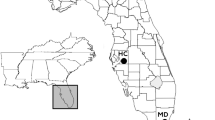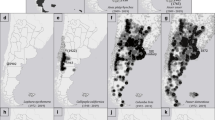Abstract
On the island of Hachijojima, central Japan, a formerly abundant population of native lizard, Plestiodon latiscutatus has become endangered by predation from an alien weasel (Mustela itatsi). Recently, an alien lizard, P. japonicus, became established on the island. The impact of the alien lizard and current distribution of the native lizard were assessed by field surveys and DNA analyses. The native lizard was sparsely distributed in the western part of the island. The alien lizard occurred in the northeastern region of the island. Between these regions, several hybrid populations were identified, including some with non-F1 genotypes, suggesting that introgression is occurring. The distribution of the weasel was examined based on field observations, allowing us to estimate predator impacts on both lizard species. We found evidence that the weasel was present throughout the entire island, suggesting that the alien lizard was able to become established despite the presence of the weasel. This indicates that the alien lizard is likely to expand its habitat range and that introgression may spread. We conclude that P. latiscutatus populations will become increasingly endangered by the synergism of genetic introgression from P. japonicus and predation pressure from the weasel.


Similar content being viewed by others
References
Allendorf FW, Leary RF, Spruell P, Wenburg JK (2001) The problems with hybrids: setting conservation guidelines. Trends Ecol Evol 16:613–622. doi:10.1016/S0169-5347(01)02290-X
Brandley MC, Wang Y, Guo X, de Montes Oca AN, Fería-Ortíz M, Hikida T, Ota H (2011) Accommodating heterogenous rates of evolution in molecular divergence dating methods: an example using intercontinental dispersal of Plestiodon (Eumeces) lizards. Syst Biol 60(1):3–15. doi:10.1093/sysbio/syq045
Courchamp F, Chapuis J-L, Pascal M (2003) Mammal invaders on islands: impact, control and control impact. Biol Rev 78:347–383. doi:10.1017/S1464793102006061
de Poorter M, Browne M, Lowe S, Clout M (2005) The ISSG Global Invasive Species Database and other aspects of an early warning system. In: Mooney HA, Richard NM, McNeely JA, Neville LE, Schei PJ, Waage JK (eds) Invasive alien species. A New Synthesis. Island Press, Washington, pp 59–83
Goka K, Okabe K, Yoneda M, Niwa S (2001) Bumblebee commercialization will cause worldwide migration of parasitic mites. Mol Ecol 10:2095–2099. doi:10.1046/j.0962-1083.2001.01323.x
Goris RC (1967) The reptiles and amphibians of Hachijojima Island. Acta Herpetol Jpn 2:25–30
Hasegawa M (1999) Impacts of the introduced weasel on the insular food webs. In: Ota H (ed) Tropical island herpetofauna: origin, current diversity, and conservation. Elsevier Science B.V., Amsterdam, pp 129–154
Hasegawa M (2003) Ecological diversification of insular terrestrial reptiles: a review of the studies on the lizard and snakes of the Izu Islands. Global Environ Res 7:59–67
Hasegawa M, Ota H (2000) Okada’s blue-tailed skink (populations on Miyakejima, Hachijojima, and Aogashima of the Izu Islands). In: Environment Agency (ed) Threatened Wildlife of Japan—Red Data Book 2nd ed.—Reptilia/Amphibia. Japan Wildlife Research Center, Tokyo, pp 66–68 (in Japanese with English abstract)
Hedges SB, Nussbaum RA, Maxson LR (1993) Caecilian phylogeny and biogeography inferred from mitochondrial DNA sequences of the 12S rRNA and 16S rRNA genes (Amphibia: Gymnophiona). Herpetol Monogr 7:64–76
Hikida T (1979) Okada-tokage (Eumeces okadae). In: Sengoku S (ed) Amphibians and Reptiles in Color. Ie-no-Hikari-Kyokai, Tokyo, p 40 (in Japanese)
Hikida T (1996) Scincidae. In: Sengoku S, Hikida T, Matsui M, Nakaya K (eds) The encyclopedia of animals in Japan, vol 5. Amphibians, Reptiles, Chondrichthyes, Heibonsha, Tokyo, pp 80–82 (in Japanese)
Hirano T (1967) Effectiveness of natural enemies for extermination of rat on Hachijo-jima. Plant Prot 21(12):517 (in Japanese)
Kato M (1940) A list of collection from Hachijo Island. Entomol World 8(80):690–730 (in Japanese)
Kraus F (2009) Alien reptiles and amphibians: A scientific compendium and analysis. Springer, Dordrecht
Kuriyama T, Okamoto T, Hasegawa M, Hikida T, Goka K (2009) Introduction of the Japanese skink Plestiodon japonicus (Scincidae, Squamata), to Hachijojima Island, in the Izu Islands, Japan. Bull Herpetol Soc Jpn 2009:124–127 (in Japanese)
Lomolino MV, Riddle BR, Brown JH (2006) Biogeography third edition. Sinauer Associates, Sunderland
Masuda R, Watanabe S (2009) Mustela itatsi Temminck, 1844. In: Ohdachi SD, Ishibashi Y, Iwasa MA, Saitoh T (eds) The wild mammals of Japan. Shoukadoh Book Sellers, Kyoto, pp 240–241
Motokawa J, Hikida T (2003) Genetic variation and differentiation in the Japanese five-lined skink, Eumeces latiscutatus (Reptile: Squamata). Zool Sci 20:97–106. doi:10.2108/zsj.20.97
Nakamura K, Uéno S (1963) Japanese Reptiles and Amphibians in Colour. Hoikusha, Osaka (in Japanese)
Okamoto T, Hikida T (2009) Three genetic lineages of the Japanese skink Plestiodon japonicus (Scincidae, Squamata) and the genetic composition of their contact zones. J Zool Syst Evol Res 47:181–188. doi:10.1111/j.1439-0469.2008.00513.x
Okamoto T, Motokawa J, Toda M, Hikida T (2006) Parapatric distribution of the lizards Plestiodon (formerly Eumeces) latiscutatus and P. japonicus (Reptilia: Scincidae) around the Izu Peninsula, central Japan, and its biogeographic implications. Zool Sci 23:419–425. doi:10.2108/zsj.23.419
Ono M (1994) Reptiles and amphibians. In: The Tokyo Electric Power Company, Tokyo Electric Power Service (ed) Report on a basic research for environment of the natural park around geothermal sites of Hachijojima Island, the Izu Islands, Central Japan. The Tokyo Electric Power Company and Tokyo Electric Power Service, Tokyo, pp 256–262 (in Japanese)
Palumbi SR (1996) Nucleic acids II: the polymerase chain reaction. In: Hillis DM, Moritz C, Mable BK (eds) Molecular systematics, 2nd edn. Sinauer Associates, Sunderland, pp 205–247
Rhymer JM, Simberloff D (1996) Extinction by hybridization and introgression. Ann Rev Ecol Syst 27:83–109. doi:10.1146/annurev.ecolsys.27.1.83
Simberloff D, Von Holle B (1999) Positive interactions of nonindigenous species: invasional meltdown? Biol Invasions 1:21–32. doi:10.1023/A:1010086329619
Taylor EH (1936) [1935] A taxonomic study of the cosmopolitan scincoid lizards of the genus Eumeces with an account of the distribution and relationships of its species. Kansas Univ Sci Bull 23:1–643
Wittenberg R, Cock MJW (2005) Best practices for the prevention and management of invasive alien species. In: Mooney HA, Richard NM, McNeely JA, Neville LE, Schei PJ, Waage JK (eds) Invasive alien species. A new synthesis. Island Press, Washington, pp 209–232
Acknowledgments
We are grateful to anonymous reviewers for critical reading and valuable comments on our manuscript. We also thank J. Motokawa and T. Hikida for providing us with specimens in their care, M. Hasegawa for providing us with several related papers and field notes, S. Nakajima, R. Mizusawa, H. Takahashi, K. Kikuchi, H. Takasu, K. Osawa, and several other local residents of Hachijojima for their assistance during our field work, and K. Suzuki and A. Tominaga for assisting with the molecular experiments. This study was financially supported by 2009 Funding To Promote Creative Research (Second Term) by the National Institute for Environmental Studies, 2011 Funding To Research Projects By Young Scientists (First Term) by the Center for Environmental Biology and Ecosystem Studies, National Institute for Environmental Studies, and 22nd PRO NATURA Foundation to T. Okamoto, and the Sasakawa Scientific Research Grant from The Japan Science Society and a grant from Fujiwara Natural History Foundation to T. Kuriyama.
Author information
Authors and Affiliations
Corresponding author
Appendix
Appendix
List for specimens collected for this study (TO, TK = private collection of Taku Okamoto; KUZ = Kyoto University Museum Zoological Collection).
-
Site 1 (Mitsune-eigo, N33°8′40″ E139°47′5″ 70 m alt.): TK-0910PJHA022–25; TK-091003; TK-091005–06; TK-100701–17; TK-1008HA04–10; TO-09319–20; TO-10019–20; TO-10036–37; TO-10044–46; TO-10057–58; TO-10063; TO-10066–67; TO-10088–92; TO-10097; TO-10111; TO-10119; TO-10121–25; TO-10134.
-
Site 2 (Mitsune-eigo, N33°8′30″ E139°47′31″ 48 m alt.): TO-10017–18; TO-10039.
-
Site 3 (Aosa-ne, Mitsune-eigo, N33°09′19″ E139°46′31″ 15 m alt.): TO-10064; TO-10068; TO-10099–101; TO-10106–09; TO-10126; TO-10132–33.
-
Site 4 (Debana, Mitsune-eigo, N33°9′24″ E139°45′18″ 71 m alt.): TK-091013; TK-100721–22; TO-10007; TO-10135–37.
-
Site 5 (Southern side of Mt. Kando, Mitsune, N33°7′36″ E139°47′48″ 44 m alt.): TO-09392–93; TO-10031; TO-10051.
-
Site 6 (Climbing trail of Mt. Hachijo-Fuji, Mitsune, N33°7′33″ E139°47′13″ 140 m alt.): TK-091012; TO-09339; TO-10059.
-
Site 7 (Southern side of Mt. Hachijo-Fuji, Okago, N33°7′13″ E139°46′50″ 126 m alt.): TK-091011; TO-10138.
-
Site 8 (Higata, Okago-eigo, N33°8′16″ E139°44′21″ 62 m alt.): TK-100718–20; TO-09420–21; TO-09423; TO-10014; TO-10033–34; TO-10060; TO-10065; TO-10072–73; TO-10094–95; TO-10128–31; TO-10142.
-
Site 9 (Chidori, Okago, N33°6′6″ E139°46′40″ 16 m alt.): TK-0910PLHA002–03.
-
Site 10 (Kashitate, N33°4′21″ E139°47′48″ 147 m alt.): TK-0910PLHA004–05; TK-0910PLHA009; TK-1008HA01–03; TO-09380–81; TO-10053; TO-10117; TO-10139.
-
Site 11 (Nakanogo, N33°4′03″ E139°48′44″ 132 m alt.): TK-0910PLHA001; TK-0910PLHA006–08.
The pure sample of P. japonicus, collected in eastern or southern Kyushu, Japan (Site A): KUZ R46921, KUZ R50385, KUZ R58312, KUZ R60367–68, KUZ R60147, KUZ R60433, KUZ R61615–17.
The pure sample of P. latiscutatus, collected in April 1996 at Tobata, Mitsune, Hachijojima (Site B): KUZ R35273, KUZ R35278, KUZ R35283–85, KUZ R35287, KUZ R35290–91.
Rights and permissions
About this article
Cite this article
Okamoto, T., Kuriyama, T. & Goka, K. An impact assessment of the alien lizard Plestiodon japonicus (Scincidae, Reptilia) on a threatened island population of the native lizard P. latiscutatus at an early phase of the biological invasion. Biol Invasions 15, 2029–2037 (2013). https://doi.org/10.1007/s10530-013-0429-8
Received:
Accepted:
Published:
Issue Date:
DOI: https://doi.org/10.1007/s10530-013-0429-8




